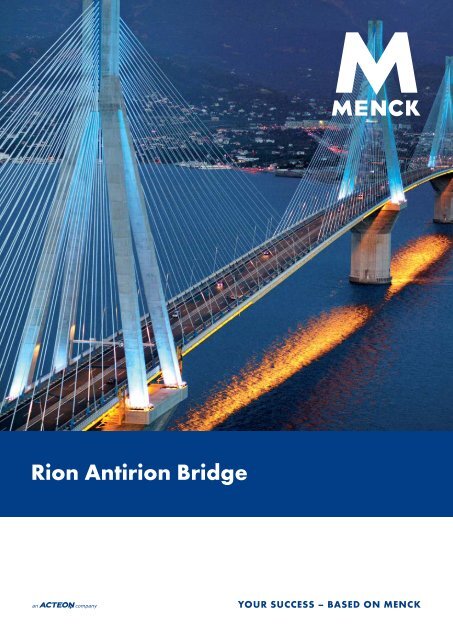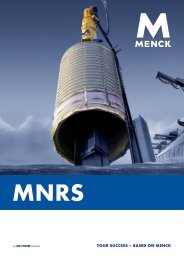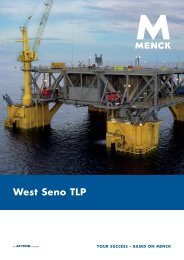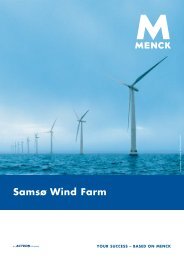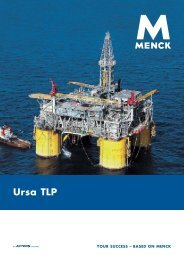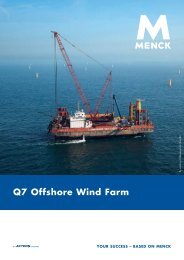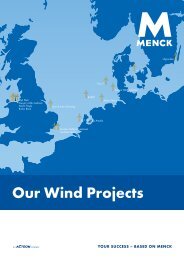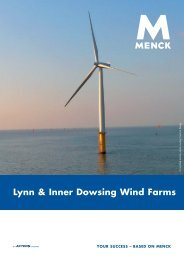You also want an ePaper? Increase the reach of your titles
YUMPU automatically turns print PDFs into web optimized ePapers that Google loves.
<strong>Rion</strong> <strong>Antirion</strong> <strong>Bridge</strong><br />
YOUR SUCCESS – BASED ON MENCK
Hammer above<br />
waiting piles<br />
As early as the 19th century, engineers had<br />
visions of bridging the Gulf of Corinth, joining the<br />
Peloponnesian peninsula to mainland Greece. It<br />
wasn’t until the early 21st century, however, that<br />
it was technically feasible to span the 2,500 m<br />
(8,202 ft) gap.<br />
The intense seismic activity in the region, continuous<br />
tectonic movement, a soft seabed and the 65 m<br />
water depth posed serious engineering challenges<br />
to the project. The answer was to build a foundation<br />
fl exible enough to cope with the tectonic movements,<br />
which could be several millimetres a year,<br />
between the North <strong>Antirion</strong> and South <strong>Rion</strong> coasts.<br />
The cable-stayed bridge is supported by four 90 m<br />
diameter reinforced concrete caissons, resting on a<br />
reinforced foundation. For each foundation, 2 m OD<br />
steel piles spaced 7 m apart were driven 25–30 m<br />
into the seabed and topped with a 3 m thick gravel<br />
layer. For the underwater piling work, MENCK engineers<br />
adapted a special pile sleeve for the MHU<br />
200T with an integrated pile gripper. This allowed<br />
the operator to lift the pile from the barge, stab it<br />
into a guiding frame attached to the bottom of the<br />
barge and then drive the pile into the ground. The<br />
angle of the leader was monitored with inclination<br />
sensors, while depth sensors monitored the position<br />
of the hammer in the water column, allowing for an<br />
even installation.<br />
Project name <strong>Rion</strong> <strong>Antirion</strong> <strong>Bridge</strong><br />
Client (end customer) Hellenic Republic<br />
Contractor Kinopraxia Gefyra<br />
Location Greece<br />
MENCK operational start July, 2000<br />
MENCK operational end March, 2002<br />
Water depth 45–65 m<br />
Installation vessel Custom-made tension leg barge ‘LISA A’<br />
Quantity of piles 600<br />
Pile diameter 2.0 m<br />
Pile soil penetration 25–30 m<br />
Number of blows per pile 1,400–1,600<br />
Hammer MHU 200T<br />
Power pack MHP 450<br />
Mobilisation/demobilisation by MENCK GmbH<br />
Mobilisation harbour <strong>Antirion</strong><br />
Demobilisation harbour <strong>Antirion</strong><br />
MENCK’s scope Mobilisation/Demobilisation,<br />
rental of MHU 200T & ass. equipment<br />
MENCK engineering External pile gripper integrated in pile sleeve<br />
Removing piles from<br />
the work barge<br />
Placing the pile into the<br />
guiding frame<br />
MENCK GmbH<br />
Industrial Area Moorkaten<br />
Am Springmoor 5a<br />
24568 Kaltenkirchen<br />
Germany<br />
Tel. +49 (0) 4191-911-0 or<br />
+49 (0) 1805-GET MENCK<br />
Fax +49 (0) 4191-911-100<br />
info@menck.<strong>com</strong><br />
www.menck.<strong>com</strong><br />
YOUR SUCCESS – BASED ON MENCK


